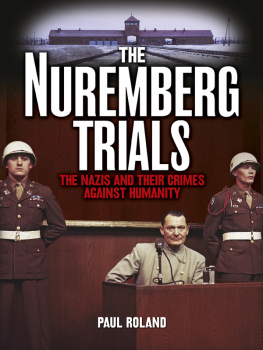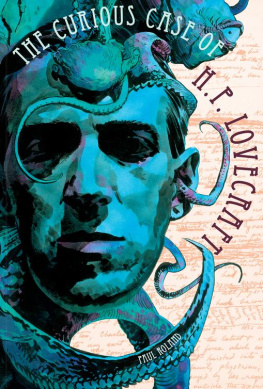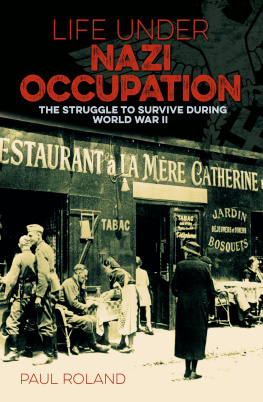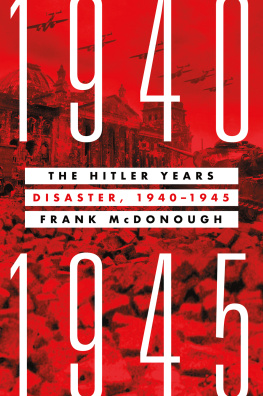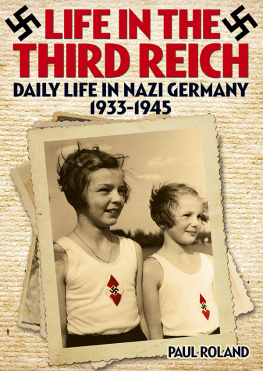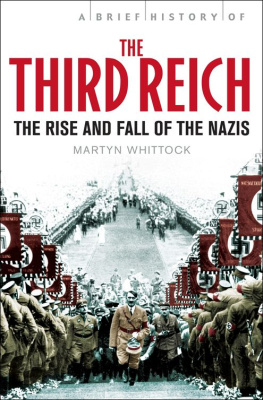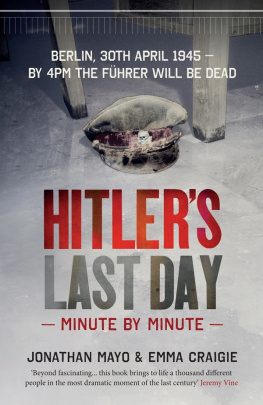
Contents
Landmarks
Introduction
Too many people here and in England hold the view that the German people as a whole are not responsible for what has taken place that only a few Nazis are responsible. That unfortunately is not based on fact. The German people must have it driven home to them that the whole nation has been engaged in a lawless conspiracy against the decencies of modern civilization.
US President Franklin D. Roosevelt
On 16 January 1945, Hitler made an unheralded return to Berlin on board his private train, the Fhrersonderzug. His reception was muted, in stark contrast to earlier official visits, when he had been greeted by a military band, deferential officials and seething crowds of adoring well-wishers.
Few risked the Allied air raids to welcome him this time.
His last gamble, the Ardennes counteroffensive, commonly known as the Battle of the Bulge, had failed, though young, inexperienced American GIs had initially been routed in the face of a German surprise attack spearheaded by heavy armour. Hitler had hoped to split the Allied advance by breaking through a thinly defended position in the American front line in the Ardennes, before pushing on to capture the strategically important port of Antwerp and in the process encircle four Allied armies. Had his strategy succeeded and it very nearly did so he would have been in a position to force the Western Allies to consider a ceasefire while he concentrated on repelling the Red Army in the east. But it was not to be. The Allies regrouped, dug in and repulsed repeated German assaults.
When the fog finally lifted, American planes decimated the Panzers and scattered the German infantry. Hitler had expended the reserves that could have been used to slow the Allied advance into Germany and his dream of repeating the blitzkrieg of May 1940 proved disastrous. It was now only a question of weeks before his thousand-year Reich would be consigned to history.
Over the following three and a half months, the Fhrer remained in the Chancellery and saw little of the devastation he had brought upon ordinary Berliners. In mid-March, he left his official residence for the last time and retreated underground to live in his bunker, commonly referred to as the concrete coffin, emerging periodically to award medals to the fanatical, underage defenders of Berlin and watch the smoke from burning buildings darken the blood-red sky. In the early hours of 29 April, he married his mistress Eva Braun in a quiet civil ceremony and on the following afternoon he said his farewells to his loyal staff. At 3.30 p.m. he retired to his study, bit down on a cyanide capsule and then shot himself in the head. Eva Braun also swallowed cyanide and died by his side.
Their bodies were carried to the shell-pitted Chancellery garden, placed in a crater, doused with petrol and set alight. There was no martial music, no elegy read at the graveside, no weeping crowds or state funeral. It was a sordid but fitting end for a man who had brought nothing but misery and untold anguish to the world.

July 1945: British and Soviet soldiers meet up at the entrance to Adolf Hitlers bunker.
German surrender
A week later, on Monday 7 May 1945 at 2.41 in the morning, Hitlers successor, Grand Admiral Doenitz, ordered the unconditional surrender of the German armed forces, bringing the war in Europe to an end. The bloodiest conflict in history had lasted almost six years and claimed the lives of more than 50 million people a number roughly equivalent to the entire population of Britain at that time. But the killing, the brutality and the suffering did not end on that day, nor in the days, weeks and months that followed.
In the immediate aftermath of the Battle of Berlin tens of thousands of German women and young girls were raped and brutalized by soldiers of the Red Army. Thousands more committed suicide rather than suffer the same fate, while others subsequently killed themselves because they could not live with the shame of having been violated.
British officers entering the wealthy suburbs of West Berlin on 4 July were appalled to find hundreds of bloated female bodies floating in the lakes. But somehow the survivors found the will to live, despite it all.
Few Germans escaped unscathed or remained unchanged by their wartime experiences. Civilians and combatants alike were affected to some degree by what they had seen or suffered. For some, their physical wounds would heal, but the psychological scars would take longer. Many never recovered.
Camp horrors revealed
Even before the horror of the concentration camps became public knowledge and the general population were damned for their complicity in the crimes committed by the regime, many ordinary Germans felt only disgust for their leaders. Housewife Hildegard Wortmann reacted to the news of Hitlers suicide on 30 April by calling him a lousy, bloody coward. And she was not alone in thinking that he had taken the easy way out.
One anonymous Berliner spoke for many when she expressed her feelings of bitterness and betrayal towards the Nazis.
The first time I had hatred for Hitler was not hatred against the terror regime, but hatred like against gangsters. Hitler promised us to win half of the world and he asked us to help him and so we have done and now we have nothing.
Those Germans who had been political opponents of the regime and so were accused of being enemies of the state the so-called undesirables and outsiders were liberated from the concentration camps, the slave labour camps and the Gestapo prisons.
It wasnt only the Jews who had suffered. As many as 250,000 Romany people had been murdered in the camps, as well as three million Poles among a huge number of others. Countless victims whose names would never be known had been tortured, starved, beaten and exterminated for their religious beliefs, their political opposition to the regime and even for their sexual orientation. Some had been condemned on the mere word of a spiteful neighbour or other informant.
In total, more than 14 million people had died as a direct result of Hitlers Vernichtungskampf (war of annihilation) against the Slavs and his Rassenkampf (war of racial extermination) against the Jews.
In Auschwitz the four main gas chambers could each hold up to 2,000 people. The marshland behind the camp where their ashes and remains were hastily deposited is today ten feet thick in human bonemeal.
Only 700,000 survived the camps, but their ordeal was not over. They then had to choose between trying to rebuild their lives in the midst of their former persecutors or turning their back on their country to start a new life elsewhere.
Starving civilians
Hitler had boasted that the Third Reich would last a thousand years, but it had been brought to a devastating and ignominious end just 12 years later. And yet some former members of the Hitler Youth were not prepared to admit defeat. They belonged to the underground of fanatical resistance fighters known as the Werewolves, who were willing to continue the struggle long after the official surrender. They would use their youth to lure unsuspecting GIs into lethal traps.
According to US Army instructional films and booklets, pretty Fruleins posed a far more serious threat to young soldiers than the risk of contracting a social disease.
Youll see a lot of good-looking babes on the make there. German women have been trained to seduce you. Is it worth a knife in the back?
Next page

